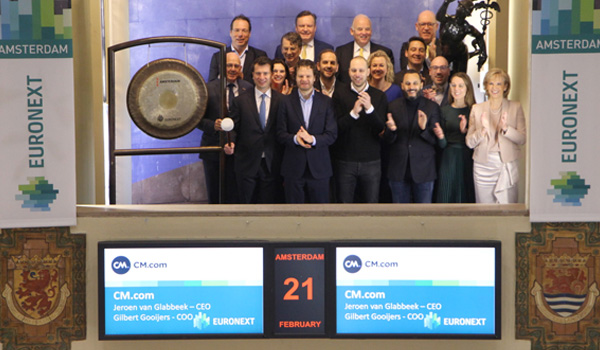- Going Public: A Childhood Dream Come True
- COVID-19: A Challenge and an Opportunity
- Adapting to the Situation
- Partnering with the Dutch Grand Prix
- More Flexibility with a New Structure
- Embracing Future Changes
Going Public: A Childhood Dream Come True
Let’s start with one of our most exciting moments: going public. In February 2020, we officially listed on the stock exchange, but the road to get there wasn’t easy. We became the first Dutch tech company to go public via a SPAC (Special Purpose Acquisition Company).
“We were unique because we got this big without outside investors,” explains Jeroen van Glabbeek, CEO of CM.com. “We reinvested our profits back into the company. When we went public, it was mainly to raise funds to grow faster. Plus, it was a way to make the company truly ours, as a team. While it always felt like a collective effort, legally it was just Gilbert and me. We wanted to change that by giving all our employees shares.”
Jeroen had dreamt of going public since he was 14, but when it finally happened, the celebration was brief. “It lasted about a nanosecond,” he jokes. Gilbert adds, “That day felt kind of like a wedding, with Jeroen and me as the couple. There was a red carpet, we posed for photos, and all eyes were on us.” Jeroen adds, “But soon enough, we were back to figuring out what needed to be done that afternoon.”
The journey to the IPO was intense. It involved legal hurdles, drafting prospectuses, and traveling around the world to meet potential investors. “You never know what the world will look like in a year,” Jeroen recalls. “We started in October 2019, amid Brexit, Trump, and tensions in the Middle East. And after the IPO, we suddenly found ourselves in the middle of the COVID-19 crisis.”

COVID-19: A Challenge and an Opportunity
Then came COVID. While many businesses were in survival mode, we shifted gears and, most importantly, stayed flexible. Parts of our business grew as demand for communication and scheduling systems surged, but other areas—like our ticketing business—completely shut down. Events were canceled, festivals postponed, and museums closed their doors. Reflecting on this in a podcast, Jeroen and Gilbert shared:
“We had to pivot quickly and figure out how to use our technology in new ways. For example, our time-slot system, which was originally built for museums, was repurposed for vaccination and testing appointments. This allowed us to help the community get through this tough time.”
In the early months of the pandemic, we offered our technology for free, thinking, “We have the tools—let’s help each other out.”
Adapting to the Situation
Not every part of our business came out of the crisis unscathed. Our ticketing business, which is a key part of our platform, saw all its events disappear. Festivals were canceled, sports events stopped, and museums closed. But even in this, we adapted. “During that time, we acquired several companies that were looking to sell their ticketing operations,” explains Gilbert. “That’s how we came out of the crisis even stronger.”
One standout project during the pandemic was a collaboration with DJ Mag for a video production at CM.com Circuit Zandvoort, featuring Armin van Buuren. “No audience was allowed, but we still wanted to create something inspiring and bring some positivity,” says Gilbert. It was a perfect example of how a crisis can spark creativity.

Partnering with the Dutch Grand Prix
Around the same time, we also started a partnership with the Formula 1 Heineken Dutch Grand Prix. “It all began when Prince Bernhard told me he wanted to bring Formula 1 back to the Netherlands,” Jeroen recalls.
“It sounded impossible, but I immediately saw an opportunity to show what our technology could do.”
This partnership was a fantastic opportunity to use our services on a massive scale. From ticket sales and marketing to payments, event app, and real-time communication with visitors, we were able to streamline the entire customer experience. “With our technology, we could efficiently inform and guide hundreds of thousands of visitors, even with the limited accessibility of the circuit,” adds Gilbert. The first edition not only gave us a major platform but also proved that our software could handle the world’s biggest events. Since 2021, CM.com has been the technical backbone of the Dutch Grand Prix.
This article is part of our series "CM.com 25 Years at the Forefront of Innovation". Read our previous articles:
1. Will You Join Me at Highstreet?
2. From DIY Solutions to a World-Class Operation
3. Pushing Boundaries: The Path to Global Success
4. The Puzzle Comes Together: From Pieces to Platform
More Flexibility with a New Structure
To make our company even more agile and customer-focused, we’ve also restructured internally. By creating different business units—CM Engage, CM Connect, CM Live, and CM Pay—we can better organize our products and services and respond more effectively to customer needs. This not only gives us more focus, but also allows us to react quickly and flexibly to market developments.
“This structure allows us to let go a bit more and gives the business units the freedom to make their own decisions,” says Gilbert. “It helps us stay closer to our customers, respond faster to their needs, and give more autonomy to the teams who are on the ground doing the work.”
Embracing Future Changes
Looking back over the past five years, we’ve learned that with flexibility and resilience, any challenge can turn into an opportunity. Our IPO, the COVID-19 crisis, and the Dutch Grand Prix partnership were all moments where we had to reinvent ourselves—and that’s exactly what we did.
“And this is just the beginning. We’ll keep adapting to the world around us. We’ve already begun major shifts, like the transition from SMS to WhatsApp and the integration of AI,” says Jeroen. “Now it’s time to refine and build on these step by step.”
Whatever changes come our way, we’re ready to keep building the future with our partners and customers.
